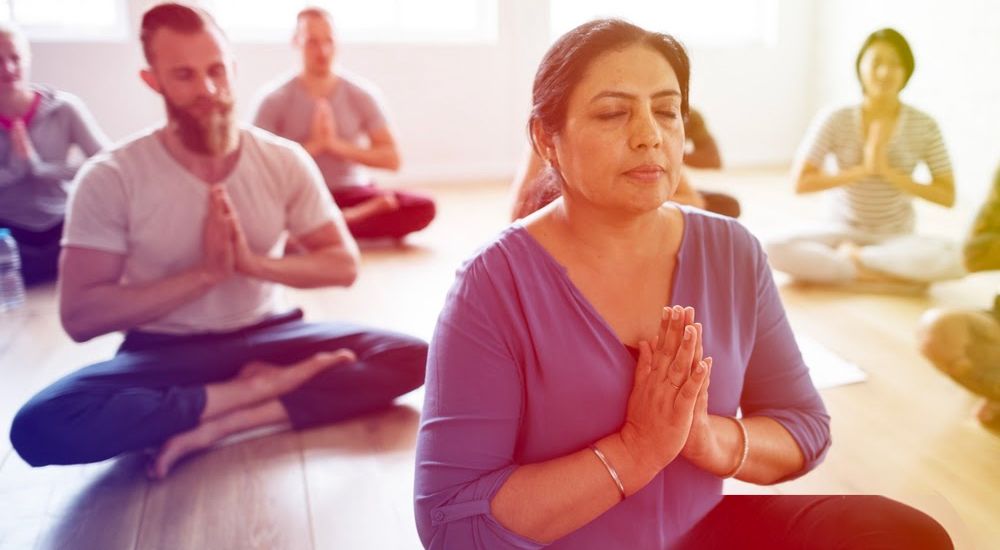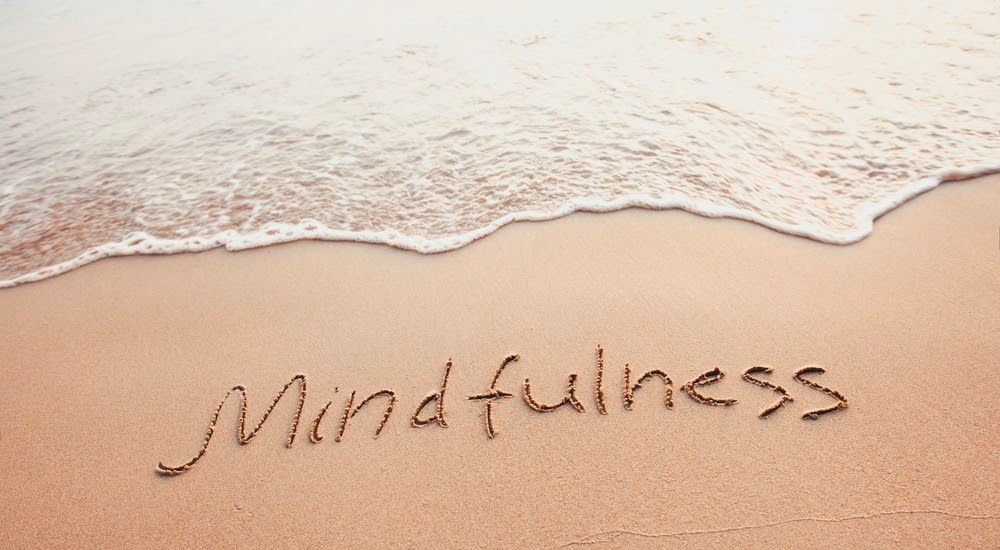A meditation practice is a powerfully effective tool for relieving stress and anxiety. This has been a known fact for decades, but only recently have researchers been able to identify exactly why meditation is so effective. It’s only been in just these past several years that advances in neuroimaging have finally revealed the science behind why meditation is an antidote for anxiety.
You see, the original purpose of meditation is to bring our minds into a state of present moment awareness. In the present moment, we can observe only what surrounds us, and we have power in the present moment. The power to choose what we do next. The source of much stress and anxiety is habitually summoned within our minds through revisiting old hurts from our past, and worrying about what may happen next in the future. When we ground ourselves in the present moment, we allow our minds to release the burden of thought about the things we cannot change from our past, and about the things that haven’t happened yet or may never happen in the future. These past and future thoughts conjure within us a sense of powerlessness because we only really have control of what we do in the present moment. The pleasant side effect of taking a momentary departure from focusing on things not within our immediate control, is a reduction in stress and anxiety.
So what is the science behind the effectiveness of Meditation for relief from stress and anxiety?
‘Fight or flight’ is the name that’s been given to our innate survival mode. In the early ages of mankind, our fight or flight response may very well be the reason mankind survived. The part of our brain responsible for our fight or flight response is called the amygdala, and it is the emotional center of our brains. It is also referred to as the sympathetic nervous system. (SNS)
Human beings developed the sympathetic nervous system very early-on because at the dawn of mankind we were living in caves and potentially being stalked by saber tooth tigers. It’s very interesting to observe that the emotional center of our brains operates exactly the same way now as it did for our earliest ancestors. It’s a wonderful thing if we need to slam on our brake to avoid an accident, but the reality is that our sympathetic nervous system doesn’t know the difference between being stalked by a tiger, or being stuck in traffic. It responds the same as it always has by flooding our systems with adrenaline and cortisol.
Back in the days of eat or be eaten, these hormones made it possible for us to receive the sudden burst of stamina we needed to fend off an attack, or run like the wind. Fight or flight. Today, we have new terms for what it means when our sympathetic nervous system releases waves of adrenaline and cortisol: Stress and anxiety. Now that our lives aren’t in such peril as in the hunter gatherer days, fight or flight mode can be triggered by anything we perceive as a threat. Even if it’s just an unpleasant thought.
Here’s the good news: We aren’t cavepeople anymore! We are far more sophisticated than our early ancestors, and our brains have evolved to develop a prefrontal cortex. The prefrontal cortex is where we get our innovation, our creativity, and our higher logic. It is also home to the parasympathetic nervous system (PNS), which releases feel-good hormones that help keep us calm and focused.
Something very important to understand, is that the SNS is basically unregulated. It operates on auto-pilot, unless we activate the PNS to keep it in check, and neuroscientists have discovered that we do have the ability to pivot our systems from the SNS into the PNS at will.
Tremendous advances in neural-imaging technology throughout recent years, have made it possible to know exactly what happens to the mind when we meditate. Upon studying the biochemical effect meditation has on the brain, it has been revealed that when meditating, the prefrontal cortex becomes biochemically activated. It taps directly into the more highly sophisticated part of our brains which release the hormones that ease stress and anxiety. The more adept we are at shifting out of the amygdala and into the prefrontal cortex, the calmer and more focused we become.


Which form of meditation is right for me?
Here is a list of some of the most commonly practiced forms of meditation that are best for easing stress and anxiety. Some forms of meditation, such as transcendental meditation, require the assistance of a practitioner to guide you. This list is meant to be actionable, meaning you can do these meditations on your own to relieve anxiety, right now. The most important thing for you to know, is that you don’t need to worry about doing it wrong. Contrary to what many believe, meditation isn’t about vacuuming your mind free from all thought and sitting in total unaberrated silence. It’s about being present for whatever is happening in the here and now. At the bottom of each description I’ve included a link for a guided version of the meditation. Guided meditation is very helpful for starting a new practice, or for days when the mind is particularly loud. As you become more familiar with your practice, you will be able to guide your own meditations if you choose.
Important things to remember:
- Set aside some time and space where you can be comfortable without being disturbed.
- Observe the present moment just as it is. Mindfulness is not attempting to remove the mind of all thought, or achieving a state of perfect calm. The aim is to pay attention to the present moment, without judgement.
- When you notice judgements arise, just observe them and allow them to pass.
- Whenever you notice your mind has wandered away, gently guide it back to your breath without judgement. Mindfulness is the practice of returning again and again.
Mindfulness Meditation
Mindfulness is another term for being fully present. The goal of mindfulness meditation is to suspend all judgement of ourselves, and instead explore our sensations, thoughts, and emotions from an observational standpoint. The purpose is to gain self-understanding.
How to do it:
- Sit comfortably in a spot that gives you stability. If on the floor, cross your legs in front of you. If on a chair, rest the bottoms of both feet on the floor.
- Sit up straight, but don’t stiffen. Allow your spine to be in soft neutral alignment.
- Rest your hands on your legs wherever it feels most natural. You can have your palms facing either up or down.
- Drop your chin a little and allow your gaze to soften gently downward. You can close your eyes, or leave them open.
- Bring your attention to the rise and fall of your breath. Notice the air moving through your mouth or nose. Listen closely to the sound of the air entering and leaving your chest.
- Sit in non-judgmental observance of every thought and sensation that arises, and anytime your mind wanders away from the breath, simply notice and gently guide your attention back.
- When you are ready, lift your gaze and take a moment to notice how your mind and body feel.
Is it right for me?
Mindfulness meditation is one of the most accessible, and widely-practiced forms of meditation because the breath acts as a guide. It is excellent for grounding yourself in your body, and gaining insight into how the processes of your mind work. Deepening your understanding for how your mind processes thought, strengthens your ability to ward off anxiety.


Guided Mindfulness Meditations:
Mindful Breathing 3 minutes:
https://www.youtube.com/watch?v=SEfs5TJZ6Nk
Daily Calm 10 minutes:
https://www.youtube.com/watch?v=ZToicYcHIOU
Walking Meditation
Walking is something most of us do everyday, a habituated action that most of us perform on auto-pilot. The moment we walk out the door, our mind is usually available to go wandering, dwelling, planning, and worrying. Walking meditation is a way to get our mind to walk along with us, and allows us to experience a relaxed focus while out and about rather than paying attention only to the thoughts swirling around inside a busy mind.
How to do it:
- Find a location that allows you to walk back and forth for 10-15 paces. Choose somewhere peaceful where you won’t be disturbed. You can be indoors, or outside in nature.
- Walk 10-15 steps in one direction, and then pause to take a few deep breaths. When you are ready, turn and walk back in the opposite direction 10-15 steps. Take a few deep breaths, and repeat for at least ten minutes.
- With each step, try to notice the four basic components:
- Lifting the back foot totally off the ground
- Observing the foot as it swings forward and lowers
- Observing the foot make contact with the ground, heel first
- Feeling the weight shift onto that foot as the body moves forward
You can walk at any speed, but in some practices a walking meditation is slow and involves taking small steps. The most important thing is that it feels natural, so choose your own pace.
Focus your attention on the sensation of the breath, the movement of your feet and legs, and feeling of making contact with the ground.
Any sights or sounds that surround you, allow your senses to drink them in and focus on only what surrounds you.
Is it right for me?
Walking meditation is great for bringing the mind and body into sync. If you don’t like to sit still for long periods of time, a walking meditation can be a great alternative to most other forms of meditation that still trains the mind to be present. If you have a busy lifestyle, a walking meditation practice can be an excellent tool for grounding yourself in the present moment while on the go.
Guided Walking Meditation:
Five Minutes Mindful Walking:
https://www.youtube.com/watch?v=09EO9IJgOiI
https://www.youtube.com/watch?v=tUWMrKZ9VSU
Ten Minutes:
https://www.youtube.com/watch?v=8D3oh2Rdvyw
Fifteen Minutes:
https://www.youtube.com/watch?v=kxa8RpmVBUQ
Mantra Meditation
A mantra is a syllable or word, usually without any particular meaning, that is repeated over and over for the purpose of focusing your mind. It is not the same as an affirmation used to influence your thoughts and feelings. The mantra itself is a tool to focus your mind, and the mantra you choose isn’t necessarily that important.
Some common mantras include:
- Om
- Rama
- Yam
- So-ham
- Om namah shivaya
How to do it:
- Get into your chosen meditation position, either on the floor or in a chair.
- Sit with the spine upright in neutral alignment, and your eyes closed.
- Bring your awareness to your breath.
- Gently repeat the mantra in your mind over and over again throughout your entire session.
Guided Mantra Meditations:
Easy Mantra Meditation 10 minutes:
https://www.youtube.com/watch?v=z6tr5WpOXdU
Om Meditation 12 minutes:
https://www.youtube.com/watch?v=vH11undyI2o
Om Meditation 30 minutes:
https://www.youtube.com/watch?v=ijfLsKg8jFY
Is it right for me?
People often find it easier to focus on a mantra than on the breath. Because the mantra is a word, and thoughts are usually perceived as words, the mantra can occupy the thinking mind. It is useful for when the mind is racing with thought, and what you need is a little inner peace and quiet. An added benefit to mantra meditation, is that as your mind becomes conditioned to relax at the sound of your mantra, you can say it to yourself a few times throughout the day to bring yourself back to present moment awareness.


Loving Kindness Meditation (Metta Meditation)
Metta is a Pali word that means kindness, and good will toward others. The benefits of Loving Kindness Meditation include boosting the ability to empathize with others, and the activation of positive emotions. The goal is to generate a more loving attitude toward oneself, increased self-acceptance, and a greater sense of competence about one’s life.
How to do it:
- Sit down in your meditative position, either on the floor or in a chair.
- Close your eyes and begin to generate in your mind and heart, feelings of gratitude toward yourself.
- Next think of a close friend, and send them your love and gratitude.
- Now think of a neutral person. Someone you don’t know that well, but you sense could use some love and kindness sent their way.
- Next, think of a difficult person in your life. Focus not on why they are difficult, but on simply sending them your love and kindness as a gesture of goodwill toward all of humanity.
- As your feelings of good will progress, spread them out across all living things on the planet, great and small.
Is it right for me?
Loving Kindness meditation is great for those who struggle with their own self-acceptance. It’s also very useful for those who live or work with people that have difficult personalities. If you have a job that requires you deal with a lot of different people on a regular basis, this form of meditation may be very good for you.
Guided Loving Kindness Meditations:
Five minutes:
https://www.youtube.com/watch?v=VjfCS88Gc7Q
Ten minutes:
https://www.youtube.com/watch?v=1eLKEuJkggw
There are many different ways to meditate, and in fact any enjoyable activity can be a meditation when we are in a state of present moment awareness. As an anecdote for anxiety, it is recommended to use meditation as a practice. It doesn’t need to take long, and it can be done anywhere you can get a few private moments. When just beginning a meditation practice, it’s okay to start with even just 3-5 minutes at a time, and build your way up to longer sessions as you adjust to your practice. During moments of peak stress-levels, meditation can be a quick and accessible tool for shifting your mind into a more relaxed state.



